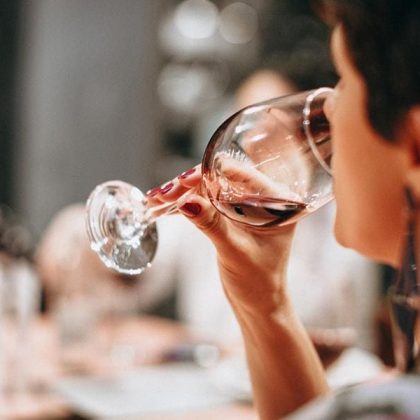Knowing your wine-or how to shine in society: from service to tasting
When to decant your wine? Some rules to follow!
As I’m sure you’ll agree, one of the pleasures of having friends over for dinner is in the meticulous planning of a delicious meal. So after agonising over which wines to match with each course, it’s only natural that you might want to avoid making a faux pas when it actually comes to serving them.
When serving the bottles of wine you have carefully selected to wash down each course of your social gathering, they cannot be treated all equally. In this respect, the age of the wine is an important factor when deciding when to decant it.
For instance, you have picked out a young yellow wine, a Vacqueyras Domaine de Longue Toque 2016 or a Côte Rôtie Laurus 2015, perhaps? This is the perfect excuse to bring out that pretty flared decanter to let the wine rest for one to three hours before being moved to the table. In contact with the air, the wine will oxygenate and its aromas and flavours will become more fully expressed. You will give your wines an even greater chance of developing in intensity and melting on the palate. Even if white wine is more susceptible to oxygen than red wine, it’s worth knowing that you would do well to briefly decanter a full-bodied and rich white wine like an Hermitage Laurus 2015.
To treat your friends you might want to break open a bottle of a powerful, opulently structured wine that you have cellared for several years, such as our Hommage à Gabriel Meffre 2003 or 2010, a fine specimen of a Gigondas. Now this is a wine for which decanting is a necessary precaution: not just to avoid pouring the deposit formed by the tannins into your guests’ glasses, but more importantly to release all of those wonderful aromas. For the best results, first stand the bottle upright for several hours before serving so the deposit can fall to the bottom of the bottle. Then, pour the wine slowly into a slender carafe with a narrow opening. Stop pouring when the deposit begins to surface. Do this just before serving your guests. When dealing with an old vintage, oxygen can rapidly deteriorate the quality of the wine and the more fragile aromas can literally disappear.
Bold pairings for the wow factor
When it comes to the question of food and wine pairings, a tip that never fails and is easy to do is to simply match the colours. You won’t be taking any major risk if you pair:
– a white wine with fish, seafood and shellfish or poultry
– a red wine with beef, lamb or game
– a rosé wine with charcuterie, sausages on the barbecue or grilled salmon.
However, if you are tempted to take you and your guests outside your comfort zone and try some totally unexpected pairings, we can recommend the following unions.
A natural sweet wine such as a Muscat de Beaumes de Venise Laurus with a blue cheese like Fourme d’Ambert or Roquefort. It can also be highly appreciated with Thai cuisine or Peking duck, playing on the sweet and sour combination so deliciously associated with Asian cooking. Similarly, if teamed with a spicy dish, this wine will make the perfect foil for the piquant flavours.
A fine, tender wine with soft tannins patinated by time like a Laurus Châteauneuf du Pape – 2010 vintage served with a flaky fish such as monkfish, bass, turbot or sole. Best served chilled.
A dry fruity wine like Côtes du Rhône Bio Gabriel Meffre with beef tataki. Its elegant white-fleshed fruit notes will delicately enhance the flavours of the lightly seared meat. Excellent too with goat’s or sheep’s cheese!
Soon wine will hold no more secrets for you! And you can take delight in the fact that your wine etiquette, be it how you serve your bottles or the surprising food and wine pairings you have tried out, will be forever engraved on your guests’ minds. To improve your knowledge, why not develop your skills in the art of wine tasting by attending one of our introductory workshops !
Rubrics
Découvrez plus d'articles...

The vineyard and wine cellar in winter
What happens in the world of wine during the winter period? After the hustle and bustle of autumn, the harvests and vinification process, comes winter, a season devoted to maturation and looking after the vines.

In 2018, we will continue to strive to be a Responsible Company!
In this new year, our wish to help build a world that respects both mankind and the environment is as strong as ever. This can be seen through the number of our projects for 2018 that are closely related to our convictions as a Responsible Winery. We’re delighted to be given the opportunity to tell you about them!

Discovering the art of pairing wine and chocolate
A morsel of white chocolate, Black Forest gâteau, pieces of stem ginger wrapped in chocolate, or Mexican chicken in chocolate sauce—all very appetising, but which wine would you serve with each one? Food and wine pairings factor in a combination of elements, such as the terroir, our powers of concentration, the circumstances of the tasting session, our sense memory and more. We guide you through some of the basic principles of this fascinating world!







